Dr Vino's wine blog
wine talk that goes down easy
Bigger is better: Gru Vee in one liter
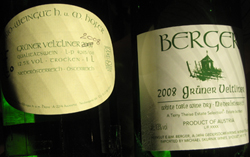 We all know bigger is better. No, not that way; get your mind out of the gutter. When it comes to wine, the reason is at least twofold. First, a bigger bottle has a lower carbon footprint per ounce of wine because there’s a more favorable wine to packaging ratio. Second, more wine!
We all know bigger is better. No, not that way; get your mind out of the gutter. When it comes to wine, the reason is at least twofold. First, a bigger bottle has a lower carbon footprint per ounce of wine because there’s a more favorable wine to packaging ratio. Second, more wine!
I’m not sure how important the first of these two reasons is for wine consumers but the second is one of those things that everybody can agree is a good thing.
And so they have. Jonathan Schwartz, the hirsute portfolio manager of Terry Theise wines for distributor Michael Skurnik, says that sales of his five one-liter Gruner Veltliners from Austria have been zooming. “Restaurants like them because it’s an extra glass and a half per bottle for wine-by-the-glass pours. Wine shop customers like them because it’s a glass and a half more wine.” (A standard bottle has 750 ml.)
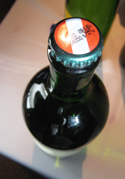 He said that people are interested in the closure too, which on the Hofer and the Berger, the two best selling of the wines, is a crown cap (think: beer).
He said that people are interested in the closure too, which on the Hofer and the Berger, the two best selling of the wines, is a crown cap (think: beer).
So which is better? I tasted them at the Skurnik tasting today. Both are simple versions of Gruner Veltliner, clean and zesty with a minerally verve. The 08 Berger (about $11; find the 2007 or the 2008) is slightly softer and the 08 Hofer slightly more tart (about $11; find the 2007 or the 2008). The wines are both an easy extension for people who love pinot grigio but are looking for something new. Hofer is made biodynamically, which goes to show that biodynamics and low price are not antithetical to each other. Berger is practicing organic. Gru Vee.
Putting water in my own wine boycott
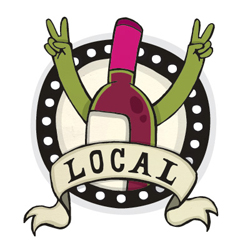
Events have conspired, the plot has thickened and now I call on you to say “non” to only one-third of Beaujolais Nouveau this year!
As you may recall, last week I asked you to ditch Beajolais Nouveau this year because of the high carbon footprint of the wine. The rush to bring this proto-wine to the world’s shops on the same day, November 20 this year, means that airfreight is commonly used, increasing the greenhouse gas emissions of the wine by at least fourfold for New York and many times more to places like San Francisco, Santiago, and Tokyo.
Word floated in to the Dr. Vino tower that major changes were afoot this year in Beaujolais with this year’s Nouveau. So I picked up the phone and called France (at the low rate of 2.3 cents per minute). First up, I spoke with Inter Beaujolais, a regional trade authority, where I learned that Beaujolais Nouveau last year had a volume of about 48 million bottles, about a third of the region’s production. Further, the Nouveau for EU destinations is not permitted to leave the region until November 13 this year, giving it a week to get places like Amsterdam and Athens. But non-EU destinations were given a special extra week this year and could leave the EU on November 6. Could it really get to store shelves in New York City by November 20?
To find out I called Georges Duboeuf, the largest shipper of Beaujolais Nouveau with around three-quarters of the Beaujolais Nouveau market. Read more…
Improbable food-wine pairings! Value vino and legumes edition
We often talk about those impossible food wine pairings; here are three improbable food wine pairings that I had recently that worked.
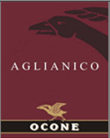 Food: sauteed green lentils
Food: sauteed green lentils
Wine: Ocone aglianico 2003 (about $15; find this wine)
Every year at about this time we make a lentil minestrone that is so good that it has even gotten approving nods and slurps from carnivores. But it takes a lot of time, ingredients and three pots. This quick version uses the same green French lentils but is a lot easier with just some onion and garlic and a quick boil all in one pan. The result is dish rich in earthiness and umami. The biodynamically grown Ocone aglianico (about $13; find this wine) really picked up on it and registered one of those desired pairings that improved both the food and the wine.
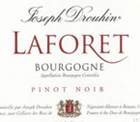 Food: Trader Joe’s Dal mahkani
Food: Trader Joe’s Dal mahkani
Wine: Drouhin, Laforet, Bourgogne rouge (about $13; find this wine)
We’ve talked about Indian food before; in fact, we’ve even talked about Trader Joe’s Indian before! And while pinot noir under $25 is pretty rough terrain without terroir, pinot noir under $15 mostly something straight out of Fear Factor. But this, the lowliest Drouhin made, would surely outclass most pinot sold by the glass. To my surprise, the lightness of the red really worked with the dal!
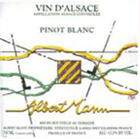 Food: homemade vegetarian chili
Food: homemade vegetarian chili
Wine: Albert Mann, pinot blanc, Alsace 2007 (about $16; find this wine)
I uncorked a Bandol red with six years of age on it that I thought might work with vegetarian chili; it didn’t. The tannins on this mourvedre were still too huge and the fruit was miserly. But I shifted gears and tried this biodynamically grown pinot blanc that was at the bottom of the Dr. Vino cave and it was a great match! Full and rich, but with a good accompanying zip, pinot blanc balanced the spiciness of the chili. The only complaint from the guests on this one was that it was too easy to drink.
Thierry Puzelat: rebel winemaker
Crises–they’re everywhere, not just the financial markets. In France, the low-end producers have been in crisis for some time with adjustments in global demand and European policy. And for appellation wines, theoretically high-end of the quality pyramid in France, the crisis is that the system is now approving bad wines while squeezing out producers who dare to be different. I explore these issues in my book, Wine Politics, and Mike Steinberger offered his own recent broadside against the AOC system in discussing the celebrated case of Jean-Paul Brun’s 2007 Beaujolais. In a nutshell, the wine tastes great and was denied the appellation while truckloads of insipid wines were given the green light since they were deemed “typical” in an AOC taste test.
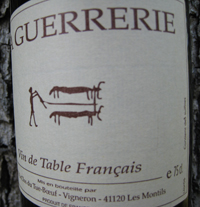 In a series of posts, I’ll be exploring some of the producers who have decided for whatever reason to make their quality wine outside of the appellation system in France.
In a series of posts, I’ll be exploring some of the producers who have decided for whatever reason to make their quality wine outside of the appellation system in France.
And one of my favorite such producers is the super-naturalista and heirloom grape cultivator Thierry Puzelat in the Loire. I’ve been reluctant sometimes to pour wines made from the hipster grape variety to an audience of non-wine geeks. But I poured his Pineau d’Aunis (about $20; where to buy?), at a recent at a recent event in Chicago but it rocked the house.
But the wine for today is La Guerrerie (about $20; where to buy?). Since it is bottled as the lowly administrative category vin de table, it can’t state grape, place nor vintage. Thus it is simply La Guerrerie, which I thought was some sort of cheeky name riffing on “war” (la guerre) for the struggle with the authorities. But it is not so. I queried the wine’s US importer, Joe Dressner, who replied:
Guerrerie is a site, about 68.37% Côt [malbec] and 31.18% Gamay. Folklore has it that the spot was where the ancient gangs of the area used to rumble, or something like that. But no one is certain. Nevertheless, that is the name of the plot on the map. It doesn’t have the AOC because the wine took a long time to finish and it was not in a tastable form when the AOCs were evaluated.
The wine, with only a dash of sulfur added before bottling, is dark in color with great aromatics, particularly a grind of pepper. The wine has some fruit, lively acidity and a fun level of tannins that make it substantial and extremely rewarding–a perfect red for fall weather since it’s got more heft than a straight gamay but not as much as, say, a barrel-aged cabernet.
For more on the Puzelat brothers, including photos and why he has to maintain to wine making facilities 50 years apart, check out a very thorough post on Bertrand’s Wine Terroirs. And don’t forget how well Thierry Puzelat did as the Cinderella in Wine Madness!
Talking and tasting climate change and wine at the AMNH
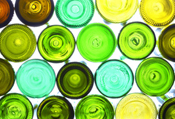 Come spend a night at the museum! I can’t promise that Ben Stiller will be there or that the dinosaurs will come alive but hopefully it will still be a good show.
Come spend a night at the museum! I can’t promise that Ben Stiller will be there or that the dinosaurs will come alive but hopefully it will still be a good show.
As a part of the launch to their new exhibit “Climate Change: The Threat To Life and A New Energy Future,” I’ll participate on a panel at the American Museum of Natural History about wine and climate change on October 28. Gregory Jones, a leading researcher on how climate change affects wine growing regions, will be flying in from Southern Oregon University. I’ll be talking my own research findings about the carbon footprint of wine. And Evan Springarn of David Bowler Wines, an importer and distributor, will talk about the various shades of eco-wines. Best of all, he’ll be bringing four such wines for us to taste!
Head on over to the AMNH web site to book your tickets ($20) now and prepare to stimulate the mind and the palate.
Philippe Pacalet, a rule breaker making natural Burgundy
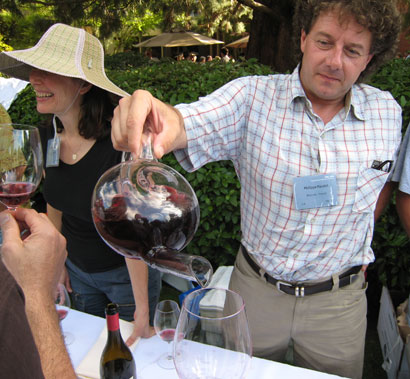 Mike Steinberger posted a piece to Slate.com on Friday detailing the folly French appellation politics (entitled “How Bureaucrats Are Wrecking French Wine”). I’m glad to see the topic getting a broader airing since it is at the heart of my book, Wine Politics, which Mike kindly mentions. But go check out the article and see Mike’s plan for AOC reform if he were French wine czar for a day.
Mike Steinberger posted a piece to Slate.com on Friday detailing the folly French appellation politics (entitled “How Bureaucrats Are Wrecking French Wine”). I’m glad to see the topic getting a broader airing since it is at the heart of my book, Wine Politics, which Mike kindly mentions. But go check out the article and see Mike’s plan for AOC reform if he were French wine czar for a day.
Mike mentions the growing ranks of quality producers who have had wines refused by the tasting portion of the appellation process. When the list includes names such as Jean Thevenet, Didier Dagueneau, Eloi Dürrbach, Marcel Lapierre, Thierry and Jean-Marie Puzelat, Marcel Richaud, Georges Descombes, and Philippe Jambon, you’ve got to wonder if that doesn’t say more about the appellation politics itself. But there’s one other notable rule breaker who could be included in that list: Philippe Pacalet. Read more…
Box wine: responses to your comments on Drink Outside the Box
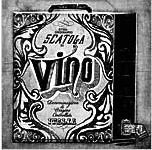 Thanks so much for the reactions to my op-ed, “Drink Outside the Box,” in Monday’s NYT. The interest astonishingly drove it to the #1 most emailed story on nytimes.com! (And then some guy named Mikhail Gorbachev came along and knocked me off the list.) With the interest has also come reactions and I thought a post was in order to respond to some of the many important issues you raised both on the previous posting on this site as well as in the comments section on the Times’ site.
Thanks so much for the reactions to my op-ed, “Drink Outside the Box,” in Monday’s NYT. The interest astonishingly drove it to the #1 most emailed story on nytimes.com! (And then some guy named Mikhail Gorbachev came along and knocked me off the list.) With the interest has also come reactions and I thought a post was in order to respond to some of the many important issues you raised both on the previous posting on this site as well as in the comments section on the Times’ site.
One point I’d like to underscore is that by far the majority wines in the US are consumed, oh, about an hour after purchase. There’s a joke in the wine trade that we Americans do have wine cellars–they’re called the back seat of the car.
Another important point is about freshness. Wine bottled with cork closure can be with oxidized or, worse, plagued by TCA, also known as cork taint, which afflicts annoyingly high percentage of wines–nobody knows for sure, but one bottle per case is certainly a plausible guess. Do you really want to donate eight percent of your wine budget to spoiled wines gods? For box wine, this is not an issue since there is no cork.
Finally, I’m really excited that nine out of every ten respondents in the poll say they would try good wine in a box. I think wine consumers–or a strong subset of consumers–are really ahead of the trade on this issue. With good wine, box wine’s longtime stigma can be used as a counter-culture sign of hipsters!
Okay, let’s roll with your questions and comments about recycling, aesthetics, wine picks, and more!
How is putting wine in a plastic bag with a plastic spigot more environmentally friendly than using recyclable glass?
— GG, Minnesota Read more…



